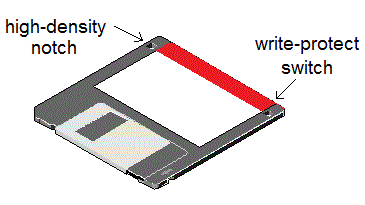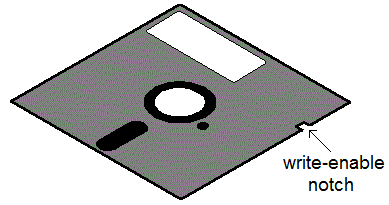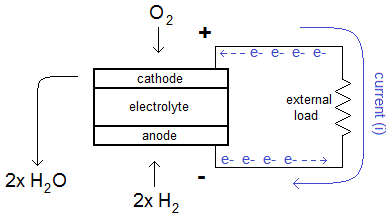- F (or type F)
- See cable connector.
- F2P
- Free To Play. An Internet game with no up-front cost to play... but see DLC.
- fab
- Another term for a foundry, or for the manufacturing process that goes on there.
- factoid
- An unverified claim presented as truth. The popular definition – a trivial fact – is properly a factette.
- FACTS
- Flexible Alternating Current Transmission System. Decision-making component of a smart electrical power grid.
- FAQ
- Frequently Asked Questions. A list of answers to common or basic questions provided for relative newcomers to a topic.
- farad
- Named for British scientist Michael Faraday (1791-1867). The standard unit of electrical capacitance. A device has 1 farad of capacitance when a 1-volt potential across it develops a 1-coulomb charge on it. See capacitor.
- Faraday cage (or shield)
- Named for British scientist Michael Faraday (1791-1867). An enclosure formed by a conducting material, usually metal sheets or mesh. It blocks external electrical fields because the charge carriers in the shield migrate to its outside, and cluster to match and oppose any applied fields.
- Fast Ethernet
- See 802.3.
- FAT
- File Allocation Table. A family of Microsoft OS file systems, although the term also refers to the actual table that holds data about how files are stored in a drive’s physical sectors and clusters. The original FAT, often called FAT16, was introduced in 1981 with MS-DOS. It used 16-bit entries, limiting hard disks to 216 = 65,536 clusters. Even at the maximum cluster size, an inefficient 8 kB, FAT16-formatted hard drives were limited to 512 MB. Starting with DOS 5.0, up to four FAT partitions per hard drive were allowed, supporting drives up to 2 GB. Windows 95 OSR2 introduced FAT32, with 32-bit entries supporting up to 2 TB of disk space – which sounded impossibly big at the time. There’s also FAT12, which is used only on floppy drives. The FAT file systems have no file ownership or file-level access control, so access to a drive means access to everything on it.
- After Windows 95, Microsoft transitioned to NTFS. See also VFAT, exFAT.
- FAW
- Frame Alignment Word. A unique digital sequence that allows a transmission system to re-synchronize its data frames in the event of error. It’s typically at the beginning of each data frame.
- fax
- Facsimile. A surprisingly old technology for transmitting copies of a document over a telephone line or, more recently, a wireless link. Telegraph versions with manual image input date to the 1840s. Image scanning (analog, of course) for phone-line transmission appeared in the 1880s. The modern telephone fax machine is a digital scanner/printer mated to a special-purpose dial-up modem.
- As of the mid-1990s, the standard faxing process is: 1) After dialing, caller uses V.21 fax protocol to establish a 300 b/s link and send a station ID, followed by a single HDLC frame. 2) During a 200 ms window, the two machines negotiate a maximum sending speed that depends on hardware and line conditions. The caller sends null characters at the negotiated speed, and the receiver acknowledges. 3) Caller sends data with no protocol or error correction. At the end of each page, caller sends an EOM and drops back to 300 b/s. 4) If there are more pages, step 2 is repeated in case line conditions have changed, then step 3. If the message is done, both systems hang up. See EOL.
- FBAR
- Thin-Film Bulk Acoustic Resonator.
- FB-DIMM
- Fully Buffered Dual In-line Memory Module. Under DRAM, see DIMM.
- FBG
- Fiber Bragg Grating. See Bragg grating.
- FBGA
- FineLine Ball Grid Array. See JEDEC.
- FC
- (1)
- Fibre Channel. A high-speed serial communications protocol, primarily for storage systems on networks. Despite the name, it can use fiber or copper media.
- (2)
- Face Contact. See fiber.
- FC-AL
- Fibre Channel Arbitrated Loop. A 100+ MB/s subset of the Fibre Channel (FC) standard, intended to replace SCSI for network storage. It supports a ring topology with up to 126 devices on a single port, plus hot-swapping, 30m coaxial cable links, and PnP. Only one pair of devices on the ring can talk at a time.
- FCC
- Federal Communications Commission. The US government agency formed in 1934 to regulate telecommunications. They’re at www.fcc.gov.
- FCT
- Functional Circuit Testing. Verifying correct performance of an electronic circuit, a higher-level form of testing than ICT.
- FDD
- (1)
- Frequency Division Duplexing. Assigning transmit and receive signals to different frequency bands of a shared channel. ADSL often uses this method, as do some full-duplex modems. W-CDMA does this for its uplink and downlink, with a constant-frequency offset between them. See ADSL, CDMA, V.##.
- (2)
- Floppy Disk Drive. An obsolete computer storage device for reading and writing floppy diskettes. By convention, the first floppy drive installed in a PC is drive A:\ and a second floppy drive is B:\. In the 1980s and 1990s, internal floppy drives used the same IDE motherboard data connection as hard drives and compact-disc drives.
- The default BIOS configuration of most PCs that have a floppy drive is, if a floppy is inserted, to boot from it rather than from the hard drive. The floppy must be formatted as a boot disk for this to work.
- FDDI
- Fiber Distributed Data Interface. An ANSI standard for data formatting and transmission on fiber-optic cable. It specifies speeds up to 100 Mb/s, 1300 nm wavelength, and NRZI coding. The packet-switched LAN called “FDDI” usually operates in a dual token ring topology, with variable-length data frames. The optical fiber permits up to 2 km spacing between network nodes, and up to 500 such nodes. FDDI is therefore most often used as a WAN backbone. An extension called FDDI-2 supports voice and video as well as data transmission. The duplex cable connector it uses is called a FDDI connector. See fiber.
- FDM
- Frequency Division Multiplexing. An analog technology, standard in pre-digital telephone systems, that places signals on sub-carriers of different frequencies so as to transmit them all on a single carrier wave. Conventional filters and demodulators are used to receive the sub-carriers, so there must be guard bands between them.
- The old CCITT recommendations for FDM specify a 4 kHz voice grade channel (VGC). Twelve VGCs combine to form a Basic Group, with base frequency allocation 60-108 kHz lower sideband, and five Basic Groups combine to form a Basic Super Group (312-552 kHz upper sideband). This hierarchy continues through Basic Master Group, Basic Super Master Group, and Super Master Group. See SSB.
- FDMA
- Frequency Division Multiple Access. A type of FDM that allocates each frequency of the analog baseband to a different user. It was the signaling format for early mobile phones, the so-called 1G networks.
- FDR
- Flight Data Recorder. See CVFDR.
- FDX
- Full Duplex. Capable of simultaneous transmission in both directions. Self-interference means that FDX systems must separate the transmit and receive channels. For a wired connection, this is trivial. For RF systems, the channels typically use separation in frequency (FDD) or in time (TDD). Echo cancellation provided by DSP has the potential to overcome the need for RF channel separation, effectively doubling available bandwidth, but is very tricky to do well. Assigning the transmitting and receiving signals to orthogonal polarizations provides a partial solution.
- FEC
- Forward Error Correction, pronounced “feck”. Channel coding that adds extra bits to a digital message to support error detection and correction at the receiver. There are three broad classes:
- block code – A generating polynomial is applied to each block of k input bits to produce a codeword of length n, consisting of the k input bits plus m FEC bits, where m = [n-k]. That is, each unique k-length input produces a unique n-length output. Such a code has a data rate of k/n and is referred to as an [n, k] code – for example, a Reed-Solomon[255, 235] or BCH[31, 16] code. A linear block code is one in which the modulo-2 sum (exclusive-OR) of any two valid codewords is also a valid codeword. A perfect block code is a special case of linear codes in which 2m = m + k + 1, meaning all 2m codewords are valid. Hamming codes are a simple type of perfect block code. See also cyclic code.
- convolutional code – Vulnerable to burst errors unless interleaving is used. It uses k shift registers (often, k = 1) containing m stages each (the code’s constraint length K = m+1) to shift the input bits through serially, while applying a set of n vectors to the register contents to produce a coded output. These vectors, or generating polynomials, are typically denoted g1, g2, … gn. A convolutional code has a rate of k/n, and is described as a [n, k, m] code. Unlike block encoders, a convolutional encoder has no fixed output length. It also has memory – output depends on past as well as present inputs. Trellis decoding is used at the receiver (see Viterbi algorithm, TCM). The trellis diagram has 2m states. The image below shows two functionally identical ways of representing a [2, 1, 3] convolutional encoder with constraint length K = 4 and generating polynomials g1 = 1101 and g2 = 1011.
- iterative code – This newest class uses a relatively slow, computation-intensive, iterative process to home in on the corrected codeword. See LDPC, turbo code.
- FED
- Field Emission Display. A flat panel display that uses a grid of individually addressable electron emitters (cathodes) to paint a phosphor screen. Display contrast and response time are comparable to those of a CRT, while potentially using less power than other FPDs. So far (2019) not commercially successful.
- FEL
- Free Electron Laser. A type of laser that uses an electron beam as the lasing medium, making it tunable.
- fermion
- Named for Italian-American physicist Enrico Fermi (1901-1954), this is one of the two major classes of subatomic particles. The spin value of a fermion is a half-integer, and fermions obey Fermi-Dirac statistics, meaning they can’t share a quantum state. Fermions include electrons, protons, and neutrons. Compare boson.
- ferrite
- A strongly magnetic but non-conducting ceramic made from a combination of metal oxides, including iron. Soft ferrites don’t retain magnetic fields, whereas hard ferrites do. Magnetic tapes are coated with hard ferrite powder.
- ferrule
- The component of a fiber-optic connector that keeps the fiber in place and helps to align it. It’s typically a 2.5 mm or 1.25 mm diameter ceramic cylinder with a very precise hole through its axis for the fiber. More generally, it means a ring or band holding two things together, such as the metal ring that holds the eraser on a wooden pencil.
- FET
- Field-Effect Transistor. See transistor.
- FEXT
- Far-End Cross-Talk. See crosstalk.
- FFDT
- FDDI Full Duplex Technology. A faster version of FDDI, up to 200 Mb/s.
- FFT
- Fast Fourier Transform. See Fourier transform.
- FH
- Frequency Hopping. See FHSS.
- FHMA
- Frequency Hopping Multiple Access. A set of frequency-hopping communicators operating as a system to provide digital communications services, e.g. specialized mobile radio. They typically use the same set of carrier frequencies and coordinate their hopping sequences to minimize interference.
- FHSS
- Frequency Hopping Spread Spectrum. One of two types of spread-spectrum radio (DSSS is the other). The data signal is modulated by a narrow-band carrier that hops from one frequency to another over a wide band, with a maximum dwell time of 400 ms. A pseudo-random sequence (the chipping code) determines the hopping sequence, which typically uses 75 or more different frequencies. The codes are tied to the time of day to help with synchronization between receiver and transmitter.
- fiber
- Fiber-optic cable uses special formulations of flexible glass or clear plastic to carry its optical-frequency EM wave wave communications signals, which offer much higher bandwidth than electrical signaling. The glass types perform better than plastic, but are more expensive and fragile. The cable cladding has a lower index of refraction than the core, to create TIR. Researchers have developed hollow-core fiber lined with photonic crystal – functionally a photonic bandgap, through which light travels faster than in any solid, and with lower loss. Undersea cables, for which costs are already high and speed increases most valuable, use hollow-core fiber. See also DWDM.
- Cables can be simplex (one fiber), duplex (two fibers), or multiplex (3 or more). The fibers themselves are categorized as either single-mode (SM) or multi-mode (MM). MM fibers have a larger diameter, allowing multiple modes of light to pass through – that is, light signals can follow more than one reflective path as they propagate down the length of the fiber. Each mode can carry a different data stream, so MM fibers have higher throughput. However, interference between modes results in increased attenuation, so MM fiber isn’t well-suited for long-distance signaling. The smaller diameter of SM fibers permits only one mode, so they have lower throughput but also lower attenuation. As of 2021, SM fibers can carry 1550-nm wavelength signals with attenuation less than 0.16 dB/km, close to the theoretical limit.
- Long-distance cables still need periodically spaced all-optical amplifiers (see EDFA) to boost the signal. The spacing of amplifiers varies with type of fiber, expected data rate, and other factors, from as little as 5 km to considerably more than 100 km.
- Amplification doesn’t correct for crosstalk between wavelengths within the fiber and other types of distortion. Removing these requires the more expensive, power-hungry, delay-introducing O-E-O repeaters, also called regenerators. Again, the spacing varies with the conditions, and researchers are continually looking for ways to increase it with better signaling (e.g. solitons) and signal processing. Terrestrial fiber commonly has repeaters every 100 km or so. For undersea cables, it can be in the thousands of kilometers.
- There are scores of different fiber-optic cable connector types, but only a handful have been widely adopted. There are couplers for mating two of the same type, and adapters for mating different types. Some common ones are listed below.
- Biconic – Uses a conical ferrule for low insertion loss.
- D4 – Ceramic connector with keyed metal twist-coupling nut and 2.0mm ferrule.
- ESCON – Enterprise Systems Connection. A duplex connector developed by IBM.
- F05 – Also called the EIAJ RC-5720. Single-core.
- FC – Face Contact. A NTT-designed screw-on connector for one multi-mode or single-mode fiber. It uses a threaded keyed design to prevent rotation that could damage the fiber end.
- FDDI – Fiber Distributed Data Interface. The duplex, latching, snap-fit connector employed by FDDI networks, and also called MIC.
- LC – From “Lucent”. A small form factor (SFF) simplex snap-on connector that has a 1.25 mm ceramic ferrule and a plastic body with pull-proof latching. It resembles a half-size SC connector, and is used for high-density applications and 1+ Gb/s signals. The TIA/EIA-604-10 specification covers the physical connector.
- MIC – Media Interface Connector. Another name for the FDDI connector.
- mini-BNC – Fiber adaptation of twist-locking BNC (see cable connector), with 2.5mm metal ferrule.
- MMC – A connector with six 12-fiber ferrules, carrying a total of 72 fibers.
- MPO – Multi-fiber Push-on. An international standard multiplex connector for 12-fiber ribbon cable, based on the older MT.
- MT – Multi-Termination. (US Conec claims it’s “Mechanical Termination”, but don’t believe them.) The first duplex fiber connector, developed in Japan. It contains two ferrules.
- MTP – Multi-Termination Push-on. A US Conec multiplex push-pull connector compatible with the MPO, and meant for use with 12-fiber optical ribbon cable. Variants that connect 4, 8, 16, 24, or more fibers exist or are in the works. Some of these might be denoted as MT##, where ## is the number of fibers.
- MT-RJ – Multi-Termination - Registered Jack. A very small, low-cost, snap-on connector for multi-mode (mostly) or single-mode duplex cable. It’s based on the old MT connector, but uses an RJ-style latch. Field termination is tricky due to the need to make two perfect cleaves on each duplex connector. It came from AMP and is supported by HP, US Conec, Siecor, Fujikura, et al.
- MU – An NTT small form factor (SFF), simplex or duplex push-pull connector. Essentially a smaller SC, with the same 1.25 mm ceramic ferrule as an LC.
- SC – Square Connector. An NTT simplex or duplex connector, currently a de facto industry standard. It uses push-pull coupling with a rugged 2.5 mm spring-loaded ferrule.
- SMA905 – Fiber adaptation of SMA-905 (see cable connector), with 3.2mm ferrule.
- SMA906 – Fiber adaptation of SMA-905 (see cable connector), with 3.2mm ferrule and recessed tip.
- ST – Straight Tip. An AT&T twist-on connector for simplex multi-mode or single-mode fiber. It uses bayonet-style locking and a 2.5 mm ferrule. Durable and reliable, but declining in popularity.
- VF-45 – 3M’s Volition small form factor (SFF) connector.
- The fiber-optic laser, developed in the early 21st century, employs a fiber cable with an inner core, an outer core, and a cladding layer. Each has slightly lower index of refraction than the layer inside it. The glass of the inner core contains a lasing medium, typically ytterbium atoms. Light from LEDs is injected into the the outer core. As it propagates down the fiber, it passes repeatedly through the inner core, where the lasing medium absorbs it and emits light at a fixed frequency.
- Fibonacci sequence
- A number series noted by Pisan mathematician Leonardo Pisano Bigollo (alias Fibonacci) in 1202, in which each value is the sum of the preceding two: 0, 1, 1, 2, 3, 5, 8, 13, 21, 34, … As the sequence progresses, the ratio of each value to the value preceding it asymptotically approaches the Golden Mean.
- FIFO
- First In, First Out. A type of shift register that handles data this way. It could also be called a LILO, but it isn’t. Contrast LIFO.
- filename extension
- In MS-DOS and early versions of Windows, file and directory names had to follow the 8.3 format derived from older DEC operating systems: a name up to eight case-insensitive characters long; a period; and then an extension of up to three characters to specify the type of file (although an extension wasn’t required). These restrictions no longer apply, but extensions remain a common way to indicate file type, and are still usually three characters or less. The default setting in many versions of MS Windows hides filename extensions from the user, a potentially dangerous practice.
- The list below gives some common filename extensions. Note that an extension is no guarantee of what a file really is, but it does determine which application the operating system (and, commonly, the user) will employ to access the file. Compiled executables and script files pose a higher security risk.
- .adb – Ada Body. A source code file written in the Ada programming language.
- .ads – Ada Specification. A source code file written in the Ada programming language.
- .asf – Advanced Systems Format. Microsoft audio-video stream structure. See ASF.
- .asp – Active Server Pages. A HTML page containing ASP features.
- .aspx – A HTML page containing ASP .NET features.
- .avi – Audio-Video Interleave. Microsoft audio-video file.
- .bas – Basic. Source code in the BASIC programming language.
- .bat – Batch. A script file containing commands in the MS-DOS Batch language, potentially including calls to other command files (.com, .exe).
- .bmp – Bitmap, a simple standard for images. Formalized in 1990, it doesn’t have any sort of compression, and consequently produces large files.
- .c – Source code written in the C programming language.
- .class – Java bytecode.
- .coff – Common Object File Format. See COFF.
- .com – Command. A DOS-only command file, as opposed to .exe. Largely obsolete, which reduces the potential for confusion with the Internet .com domain.
- .cpp – Source code in the C++ programming language.
- .cs – Source code in the C# programming language.
- .css – Cascading Style Sheet. See CSS.
- .deb – Debian. A file package type commonly used for distributing GNU/Linux OS components and updates. A utility such as the Debian OS
dpkgcan unpack and install the files, which are in the Unix archive format. - .dll – Dynamic Link Library. See DLL.
- .doc – MS Word document.
- .docx – MS Word 2007 or later document, using the OOXML specification.
- .drv – Type of DLL file.
- .dvi – Device-Independent. See TeX.
- .dwf – Drawing Web Format. Image file. See DWF.
- .dwg – Drawing. AutoCAD image file. See DWG.
- .dxf – Drawing Exchange Format. 3D CAD image. See DXF.
- .edf – Circuit-description file. See EDIF.
- .elf – Executable and Linking Format. See ELF.
- .eps – Encapsulated PostScript. A PostScript document format used for graphics.
- .exe – Executable. Can be run as a command on a DOS or Windows PC. Can also be used for DLL files.
- .flac – Free Lossless Audio Code. Lossless compressed digital audio. See FLAC.
- .flv – Flash Video. Digital video for Adobe Flash Player.
- .fon – Type of DLL file.
- .gel – General Extension Language. See GEL.
- .gif – Graphical Interchange Format. Image. See GIF.
- .h – Header. A definitions source code file for the C and C++ programming languages.
- .hex – Formatted source code for the Intel 8051 family of 8-bit microcontrollers. See Hex.
- .hhc – HTML Help Contents. Contents file created by Microsoft HTML Help Workshop.
- .hhk – HTML Help Index. Index file created by Microsoft HTML Help Workshop.
- .hhp – HTML Help Project. Project file created by Microsoft HTML Help Workshop, a utility that generates a help file from linked, HTML-based documentation.
- .htm – HTML markup text. Three characters, to accommodate the 8.3 format.
- .html – HTML markup text. This extension is preferred to .htm.
- .ico – Icon. Contains one small image in a variety of sizes, color depths, etc., to use as an icon under a variety of MS Windows display settings.
- .inf – Information. MS Windows script, usually for installing drivers.
- .ini – Initialization. In MS-DOS and older versions of Windows, a text file of configuration data for an application, user account, or the OS. Replaced at the system level by the Windows Registry, and at the application level by other configuration file formats, but still used by many applications that value its user-friendly simplicity.
- .iso – Named for the ISO, which approved it. A format for an archived, compressed image of an optical disc (CD or DVD).
- .jar – Java archive. A compressed archive of Java .class bytecode files.
- .jpg – Image file. See JPEG.
- .js – Source code in the JavaScript client-side scripting language.
- .jsp – JavaServer Pages. A Web page generated with JSP, which adds Java code to a HTML framework.
- .m – A MATLAB script.
- .m4a – MPEG-4 Part 14 Audio. Audio-only MP4 file.
- .mat – A MATLAB data file.
- .mht – MIME HTML. Microsoft format for Web pages.
- .mid – Music file. See MIDI.
- .mkv – Matroška. A 2002 container file format used primarily for audio and video files. Other common extensions for it are .mk3d, .mka, and .mks.
- .mp3 – MPEG-1 Layer 3. Audio file. See MP3.
- .mp4 - MPEG-4 Part 14. Multimedia (audio/video). See MP4.
- .mpeg – Video file. See MPEG.
- .mpg – Video file. See MPEG.
- .msi – Microsoft Installer, probably. A MS Windows installation file, containing both a program executable and instructions for the operating system’s installer. The Windows installer,
msiexec.exe, runs it. Not all Windows programs come wrapped in a .msi. - .ncb – Microsoft Visual C++ IntelliSense database file.
- .obj – Object. Compiled program code, requiring a linker to convert it into a finished executable.
- .ocx – Programming object. See OCX.
- .odf – OpenOffice formula. See ODF.
- .odg – OpenOffice image. See ODF.
- .odp – OpenOffice presentation. See ODF.
- .ods – OpenOffice spreadsheet. See ODF.
- .odt – OpenOffice document. See ODF.
- .pdf – Portable Document Format. Adobe Acrobat document.
- .png – Portable Network Graphics. Open-standard image file format. See PNG.
- .ppt – MS PowerPoint presentation.
- .pptx – MS PowerPoint 2007 or later presentation, using the OOXML specification.
- .ps – (1) PostScript, an Adobe document format.
- .ps – (2) PowerShell. A script file in Microsoft’s PowerShell language.
- .py – Python. Source code in the Python scripting language.
- .rar – From Roshal Archive (developed by Eugene Roshal). Proprietary file archiving & compression format produced by the WinRAR application. It has more features than the old .zip, including encryption.
- .rb – Ruby. Source code in the Ruby programming language.
- .rpm – Red Hat Package Manager, originally; now RPM Package Manager, another recursive acronym. A file package type commonly used for distributing GNU/Linux OS components and updates.
- .rtf – Rich Text Format. Microsoft specification for documents with images and formatted ASCII text, originally based on TeX.
- .scr – (1) Screensaver. MS Windows screensaver file. This file format is really just a disguised executable (.exe).
- .scr – (2) Script. An executable script, also a format used by malware.
- .shs – Shell Scrap. A MS Windows file format for passing objects – including executable code – from one application to another under OLE or whatever. It’s a common file format for viruses, a trick called “scrap-wrapping”. The Windows Registry is usually set to hide the .shs extension, so if a virus attachment is named, say,
badnews.txt.shs, it’ll appear to be a harmless text file. - .so – Shared Object. A library file, most often using ELF.
- .sql – A SQL command script file.
- .svc – Service. A text file containing formatted information about a Windows service.
- .sys – System. Contains system settings, special functions, etc. for MS DOS and early Windows.
- .tar – Tape Archive. Unix data-backup file, not necessarily on tape. See tar.
- .tex – See TeX.
- .tgz – Also .tar.gz. See tar.
- .tif – Tagged Image File. A TIFF image file.
- .txt – Unformatted ASCII text.
- .vbs – Visual Basic Script. A file created by Visual Basic Scripting Edition (VBScript), a Microsoft scripting language pared down from the Visual Basic programming language and similar to JavaScript.
- .vbx – Visual Basic Extension. See VBX.
- .vhd – Virtual Hard Disk. See VHD.
- .wad – Game data in some computer games, beginning with id Software’s Doom. To support user customization, it’s separate from the binary code. While many sources maintain that “wad” is an acronym for “where’s all the data”, id Software says that it doesn’t stand for anything.
- .wav – Audio file. See WAV.
- .wma – Windows Media Audio. Audio file. See WMA.
- .wmv – Windows Media Video. Video file. See WMV.
- .xdr – XML-Data Reduced. See XDR.
- .xls – MS Excel spreadsheet.
- .xlsx – MS Excel 2007 or later spreadsheet, using the OOXML specification.
- .xsd – XML Schema Document. See XSD.
- .xsl – Extensible Stylesheet Language. See XSL.
- .zip – Widely used file archiving & compressing format.
- file system
- The rules and structures a computer’s operating system employs to store data as files.
- Microsoft file systems include the various flavors of FAT for MS-DOS, floppy diskettes, and early versions of Windows through Windows 95; NTFS for Windows NT and subsequent versions of Windows; exFAT for USB thumb drives and SD cards; and ReFS for servers from Windows 8 onward.
- Most of the many versions of Unix employ the Unix File System (UFS), also known as the Fast File System (FFS), but they frequently make minor changes to it, and give it new names. Linux distributions typically use extended file system (ext) or second extended file system (ext2), which are based on UFS.
- Apple computers used Hierarchical File System (HFS) until 1998, HFS+ until 2016, and Apple File System (APFS) since.
- The Compact Disc File System (CDFS) is cross-platform compatible.
- filter
- Any device that conditions a signal by attenuating specific frequency ranges. Filters fall into four broad functional categories: band pass (BPF), band stop (BSF, also called notch, band gap, or band reject), high pass (HPF), and low pass (LPF).
- The simplest (passive, first-order) filters for electrical signals are a capacitor to ground, which acts as a LPF, and a capacitor in the signal line, which acts as a HPF. A LPF and HPF in series and with overlapping ranges create a BPF, while a LPF and HPF in parallel and with ranges that don’t overlap act as a BSF.
- System requirements determine whether the desired function should be provided by a finite impulse response (FIR) or infinite impulse response (IIR) design. FIR offers linear phase response and unconditional stability. IIR types are less complex. See windowing.
- The JavaScript animation below models, in very slow motion, an in-line capacitor acting as either a high-pass filter for alternating current or an open circuit for direct current as AC or DC voltage (big red +) is applied. Note that current across a capacitor leads voltage by 90°.
- FinFET
- Fin Field-Effect Transistor. See transistor.
- fintech
- Financial Technology. Refers to (primarily) software used by banks and financial services companies.
- FIR
- (1)
- Finite Impulse Response. A non-recursive (FIR) filter has an output based only on its past and present inputs, so its output must eventually fall to zero. In the language of Z-transforms, the FIR filter response can contain zeros, but not poles. This makes FIR filters unconditionally stable. They also have linear phase response. They’re more complex than the traditional IIR filters, but provide better performance. Common FIR design approaches include sum, moving average, differencing, and comb filter. See windowing.
- (2)
- Far Infra-Red. See IR.
- firewall
- Software or firmware that protects a networked system from hostile intrusion by filtering packets (OSI network layers 3 and 4), monitoring network connections (layer 5), or checking application-protocol content (layer 7) for violations of rules. Firewalls acting at the higher network layers are, in general, more sophisticated and effective. Modern routers, operating systems, & anti-virus software usually include firewalls.
- FireWire
- IEEE standards IEEE-1394 (1995), 1394a (1998), 1394b (2001), and 1394c (2008), originated by Apple in the late 1980s, and also called the High Performance Serial Bus (HPSB). The standards define the media, topology, and protocol for both a backplane bus and a point-to-point serial cable interface. Unlike the much more widely used USB, FireWire devices run peer-to-peer, independent of a central, controlling computer. This means they need built-in FireWire controllers, increasing their cost and complexity. The cable version, meant to be a hot-swappable universal connector for all peripheral devices to a PC, supports up to 63 devices per port at half-duplex speeds of approximately 100, 200, and 400 Mb/s for 1394a, or 800, 1600, and 3200 Mb/s (rates called S800, S1600, and S3200) for 1394b and 1394c.
- 1394a cables contain two twisted pairs (A & B) for carrying differential signals, can be up to 14 feet long, and use either a 4-pin or a rectangular 6-pin connector; the two extra lines carry power. 1394b and 1394c cables use either of two 9-pin connectors. 1394c can run a S800 link over up to 100m of UTP cable. Port pinouts are shown below.
- fixed point
- A digital encoding format for numbers. It defines four possible types: unsigned integer (values 0 to 65535, assuming 16 bits), signed integer (–32768 to 32767), unsigned fraction (0 to 1), and signed fraction (–1 to 1). Negative values use 2’s comp notation. Compare floating point.
- FLA
- Fixed-Length Array. A fixed-length set of data values used in a computer program, as opposed to the more flexible but potentially risky variable-length array.
- FLAC
- Free Lossless Audio Codec. A freeware audio codec (coder/decoder) with lossless compression, released in 2001 by programmers at Xiph.org and frequently updated since. It can handle up to 655.35 kHz sampling, 32 bits/sample, and 8 channels. It doesn’t include any sort of DRM, which is why fewer hardware platforms play it. The audio files normally have a .flac filename extension. Compare ALAC.
- Flash
- A widely used, chronically insecure technology from Adobe Systems Inc. for playing video in Web page frames. No relation to flash memory. Browsers normally require a plug-in to play Flash-encoded video.
- flash drive
- Usually means a thumb drive, sometimes means a SSD.
- flash memory
- A non-volatile memory technology invented around 1980. Where it’s replaced uses of the older EEPROM, it’s sometimes, inaccurately, called flash ROM. It’s become popular for PC data storage, as both integral SSDs and removable media such as thumb drives. It hasn’t been used for PC main memory (DRAM) because of speed and longevity issues. The similar flash RAM, a volatile type, is little used.
- There are two broad classes of flash memory defined by their internal architecture: NAND-gate and NOR-gate. NAND-gate flash is more compact, cheaper, and has higher write and erase speeds, but its simpler architecture restricts it to block-level access, so it’s primarily for data storage. It also requires error-correction coding to deal with failed cells. In contrast, NOR-gate flash has higher read speeds, greater longevity, and, like the old EEPROMs, bit-level access, making it suitable for code execution.
- Flash memory can be made with cells that hold more than one bit. A single-bit NAND flash cell has two NAND-gate transistors separated by a thin oxide layer, maintaining a charged (binary 1) or charge-depleted (binary 0) region. Increasing bit count per cell makes flash storage slower, more power-hungry, and shorter-lived, but also cheaper and more compact, so the more dense types are increasingly popular in consumer products despite the resulting decline in quality. The flash sub-types:
- SLC – Single-Level Cell. One bit per cell. The bulkiest and most expensive type, but also the fastest, lowest-power, and most long-lived. NAND-gate SLC has an expected lifetime of 100,000 read/write cycles, ten times that of NAND-gate MLC. Floating-NOR-gate SLC lasts even longer.
- MLC – Multi-Level Cell. Two bits per cell.
- TLC – Three-Level Cell. Three bits per cell. Half the expected lifetime of MLC.
- QLC – Quad-Level Cell. Obviously, four bits per cell.
- PLC – Penta-Level Cell. 5 bits per cell. In development as of 2020.
- 3D NAND flash memory started appearing in consumer products in 2014. It turns NAND gate cells on edge rather than laying them out in a flat plane, so they can be packed more densely.
- FLEX
- A 4-level, FSK-based Motorola digital pager technology for alphanumeric messaging, & higher capacity on old POCSAG channels. Besides the actual pager protocol, which has become industry standard, Motorola created a FLEX operating system for portable wireless devices, a FLEX Script language, and a FLEX integrated development environment (IDE) for building messaging applications. The FLEX protocol converts over-the-air alphanumeric messages into FLEX protocol stack codewords. See ReFLEX, InFLEXion.
- FLIR
- Forward-Looking Infra-Red. A signal-processing technology used for night-vision cameras, mainly on military aircraft. It creates a real-time, visible-light image from the infra-red wavelengths of thermal emissions.
- floating point
- A digital format for encoding decimal numbers in computer memory, plus rules for manipulating them. It demands more complex hardware but permits simpler algorithms and less rounding error than fixed point.
- The IEEE-754 standard recognizes several floating-point formats. The smallest is half-precision floating point, also called binary16, which uses 16 bits. Surprisingly, it’s the newest member of the standard, formally added in 2008. It has poor precision, and it’s meant only for storing data, so it can’t be used for computations. However, it makes a good example because it has the same structure as the others:
- The MSb,
s, is the sign bit – 0 means positive, 1 means negative. The next five bits, xxxxx2, give the exponentexp. It has a bias of 15, meaning that its actual value is [exp - 15]. Finally, the lowest ten bits are the mantissa, or significand, the digits of the number. For most values ofexp, these 16 bits represent the number (-1)s × 2[exp - 15] × 1.mmmmmmmmmm2. Exponent values 0 and 31 (binary 00000 and 11111) have special meanings. - Single-precision floating point, or binary32, uses 32 bits: sign, 8-bit exponent (with a bias of 127), and 23-bit mantissa. It can represent decimal values from approximately ±1.1754944 × 10-38 to ±3.4028235 × 1038.
- Double-precision floating point, or binary64, uses 64 bits: sign, 11-bit exponent (with a bias of 1023), and 52-bit mantissa. It can represent values from approximately ±2.2251 × 10-308 to ±1.7977 × 10308.
- Double-extended floating point, the family oddball, uses 80 bits.
- Quad-precision floating point, or binary128, uses 128 bits: sign, 15-bit exponent (bias 16383), and 112-bit mantissa. It can represent values up to about 1.1897 × 104932, which should suffice for now.
- The CUNY Web site provides this tool to convert decimal values into single-precision and double-precision floating point, represented in hexadecimal form.
- floppy
- Floppy disk(ette). Any of several obsolete standards for removable computer data storage dating to the late 1960s. Physically, a floppy is a very thin, flexible plastic disk with magnetic oxide coating, inside a protective rectangular jacket. The formatting that the disk must undergo before it can accept data consumes some of its total capacity, just as it does on a hard disk drive. Diskettes are commonly sold unformatted.
- IBM began selling its 8-inch floppy, with flexible jacket and 79.75 kB formatted capacity, in 1971. The similar 5¼" floppy appeared in 1976 with formatted 87.5 kB capacity. Later common formats included 160, 360, double-sided 720, and double-sided high-density 1155 kB. It has a write-enable notch on one side; covering the notch with a label or a piece of tape write-protects the disk.
- The 3½" floppy (1980), with a rigid plastic jacket and a sliding shutter to seal it when not in use, comes in FAT-formatted capacities of 360 kB double-density, 720 kB double-sided double-density, or 1.44 MB double-sided high-density (HD), or Macintosh-formatted 400 or 800 kB. It includes a sliding write-enable switch in one corner of the jacket, which makes the disk read-only when open. In another corner, the HD types have a rectangular hole so that HD-capable floppy disk drives (FDDs) can detect their format mechanically.
- There have been other, less common disk sizes and variants, with different capacities. Disks are often referred to with rounded-up or unformatted values for capacity. For example, the 5¼" 1155 kB disk was normally labeled “1.2 MB”.
- Drives are usually backward-compatible with older disk formats of the same physical size. For example, a 3½" drive built for double-sided, double-density (720 kB) floppies can also read/write single-sided 360 kB disks, but not high-density 1.44 MB disks.
- FLOPS
- Floating Point Operations Per Second. Performance is more typically measured in megaFLOPS (MFLOPS) or gigaFLOPS (GFLOPS). TeraFLOPS (TFLOPS) and petaFLOPS (PFLOPS) are mostly restricted to the realm of theory.
- fluence
- A measure of the total number of particles – electrons, protons, etc. – of a specified energy incident on a surface (in particles/cm2). Sometimes normalized over a 24-hour day (particles/(cm2-day)), or abstracted to cover the subtended angle relative to the source (particles/[cm2-sr], where sr = steradians), or both.
- flux
- (1)
- A liquid (typically melted rosin) applied to materials just prior to soldering, mainly to prevent oxidation.
- (2)
- A measure of the total radiation incident on or field strength passing through a given surface.
- flux capacitor
- A device used to support time travel. Its activation requires a brief power surge of 1.21 GW.
- fluxon
- A quantum of magnetic flux. See RSFQ.
- flyback regulator
- See regulator.
- FM
- Frequency Modulation. The frequency of the carrier wave varies with the amplitude of the modulating signal. This is the second of the three types of RF analog modulation. The others are AM and PM. In North America, the commercial FM radio broadcast band is 88-108 MHz. Signals have 150 kHz bandwidth, so center frequency assignments are at 200 kHz intervals starting with 88.1 MHz.
- FMA
- Fused Multiply-Add. Extensions to the SIMD hardware instructions, which are themselves extensions to x86. As of 2013, tinkering by AMD and Intel has led to two very similar but incompatible versions: FMA3 (used by both companies) and FMA4 (AMD only). Compiler makers are struggling to accommodate them.
- FMT
- Filtered Multi-Tone. Multi-carrier modulation used in VDSL. It has lower spectral overlap between adjacent sub-channels than DMT or DWMT.
- FOC
- Field-Oriented Control. Also called vector control. A method of controlling variable-speed AC motors (see VFC (2)) based on treating current in the stator as a single vector defined by two orthogonal components representing torque and magnetic flux. It allows for more efficient motors that achieve full torque even at zero speed.
- FOI
- Frequency Of Interest.
- FOIP
- Fax Over Internet Protocol.
- folded dipole
- See antenna.
- fork
- (v., transitive) To create an alternate version of something, especially software. Often used in a negative sense to mean the versions are incompatible.
- Fortran
- Formula Translation. See programming language.
- FOSS or F/OSS
- Free and Open-Source Software. Software for which the source code has been published, and which anyone is free to copy and modify for their own use. See FSF, GPL.
- foundry
- A manufacturing facility for semiconductor microchips. A very expensive investment nowadays. The world’s largest in 2012 is TSMC (Taiwan Semiconductor Manufacturing Company).
- Fourier series
- Named for French mathematician Jean Baptiste Joseph Fourier (1768-1830). Any periodic signal with period T0 can be represented as the sum of a series of sinusoids, all with frequencies that are integer multiples of the fundamental frequency [1/T0]. This is a Fourier series.
- Fourier transform
- Named for French mathematician Jean Baptiste Joseph Fourier (1768-1830). A mathematical operation that converts a periodically time-varying signal into one or more weighted, complex-valued Fourier series – distinct frequencies with varying amplitudes and phases. Put another way, it converts signals from the time domain (the realm of oscilloscopes) to the frequency domain (spectrum analyzers).
- This is a fundamental step in signal processing. Instruments can’t measure frequency directly. What they can measure is voltage and time. Given a noisy, time-changing voltage, the Fourier transform reveals the frequency components buried in it.
- If the data is in discrete (i.e., quantized digital) form, the operation is a time-limited sum rather than an integral, and is called a discrete Fourier transform (DFT). Some authorities further distinguish the discrete-time Fourier transform (DTFT), which uses a discrete signal in time but generates a continuous frequency-domain output. “Continuous-time Fourier transform” (CTFT) then means continuous input as well as continuous output.
- The DFT contains many redundant calculations. The fast Fourier transform (FFT) is an algorithm for performing a DFT with fewer calculations – roughly N0 log[N0] instead of N02, where N0 is the number of samples in one signal period. It relies on either decimation in time or decimation in frequency. It plays an enormously important role in modern signal processing of all kinds. Researchers have identified ways to make it work even faster for data that groups most of its energy into a few spectral components.
- Finally, an inverse Fourier transform is the reverse operation, converting from frequency to time domain. Like the forward operation, it can be discrete or continuous.
- Compare Laplace transform, Z-transform.
- four-wire circuit
- A circuit composed of two 2-wire transmission lines, one for sending and one for receiving. Telephone companies used to offer leased lines to support four-wire circuits, but digital technologies made them obsolete.
- FPA
- Focal Plane Array.
- FPAA
- Field Programmable Analog Array. A chip that can be programmed to perform a variety of analog signal processing functions, particularly multi-pole filters, as opposed to the far more common digital FPGA. The chip contains a small number of configurable analog blocks (CABs). The contents of a CAB can vary widely. A typical CAB has an op-amp, programmable capacitor arrays, and either programmable resistor arrays (for continuous-time circuits) or configurable switches (for switched-capacitor circuits). The programmer selects circuit elements from a small set – 20 or so – of analog function blocks and interconnects them as desired. The software tool converts the resulting circuit into a data stream that programs the FPAA’s on-chip SRAM.
- FPD
- Flat Panel Display. Any computer, TV, or instrument display screen based on a technology less bulky than the venerable CRT.
- The first real commercial success for large FPD sets was the power-hungry plasma display panel (PDP), which retained a share of the large-screen TV market due to its cost and color-depth advantages even after more efficient display technologies became popular. The liquid crystal display (LCD) started small, literally, in digital watches, calculators, and other electronics, and was able to gradually enter and finally dominate the markets for PC monitors and TV sets as its technology got bigger and better (see TFT). So-called LED displays are LCDs that use a LED array rather than a fluorescent light for backlighting, reducing power consumption.
- Other FPD technologies include electroluminescent display, field emission display (FED), digital micromirror display, surface-conduction electron-emitter display (SED), organic light-emitting diode (OLED), laser phosphor display (LPD), and LCDs with quantum dot enhancement.
- FPD-Link
- Flat Panel Display Link. Widely adopted 1996 open standard for the signal format that a GPU uses to send digital video to a LCD flat-panel display. Because it uses LVDS signaling (on four STP cables), it’s sometimes called just “LVDS”.
- FPDP
- Front Panel Data Port. A 32-bit parallel bus, standardized through the VMEbus Industry Trade Association (VITA) as ANSI/VITA 17-1997. Rather than go through a backplane, it uses 80-pin ribbon cable to connect hosted devices, typically VMEbus cards. The original FPDP has a maximum 40 MHz strobe frequency, and carries up to 160 MB/s. The backward-compatible FPDP II has up to 50 MHz strobe frequency, and uses both the rising and falling edges of the strobe signal to double throughput to a maximum 400 MB/s.
- FPGA
- Field Programmable Gate Array. See PLD.
- FPI
- Fabry-Pérot Interferometer. See etalon.
- FPIC
- Field Programmable Inter-Connect device. This isn’t really a logic device like the FPGA. It’s a programmable wiring device.
- FPLA
- Field Programmable Logic Array. A ground-breaking PLD launched in 1975.
- FPS
- (1)
- Frames Per Second. The number of image frames a movie or animation displays in a second. Not to be confused with the refresh rate of the video hardware (see ATSC).
- (2)
- Feet Per Second.
- (3)
- First-Person Shooter. Any of the class of combat video games in which the player controls one character and sees events from that character’s perspective. Some games can switch between FPS and TPS.
- FPU
- Floating Point Unit. Sometimes called a math coprocessor. A component of a microprocessor for handling floating-point operations (i.e. math involving decimal points). Contrast with ALU.
- FRAM
- Ferroelectric Random Access Memory. Also written FeRAM or F-RAM. A data storage technology that’s conceptually similar to DRAM, except that it maintains state without power, making it a type of NVRAM. It applies a magnetic field with one of two orientations to a ferro-electric crystalline material in a capacitor, aligning its atoms with the field. Being read destroys its setting, so, like DRAM, it must be re-written immediately after reading. It’s fast, low-power, and more reliable than flash memory, but it’s relatively expensive and has low data density.
- frame relay
- Packet-switched digital transmission, like X.25 but without FEC. (Errors are handled by high-level protocols.) Seldom used for voice & SNA, since, unlike ATM, it can’t prioritize well. Data uses variable-length frames (packets), and voice uses fixed-length frames. The wide variation this technology permits in packet size is seen as a shortcoming, imposing bandwidth limitations. Still, it’s ahead of ATM.
- FRB
- Fast Radio Burst. A brief (in astronomy, this can mean several days), intense, broad-spectrum burst of radio waves coming from interstellar space, usually another galaxy. Astronomers determined in 2020 that these bursts originate from magnetars – neutron stars with unusually strong magnetic fields and slower-than-normal rotation.
- Freenet
- Anonymous, decentralized, file-sharing darknet project started in 2000 and hosted at http://freenet.sourceforge.net. Each user’s computer becomes a Freenet node on the Web, hosting an encrypted directory of files available to other users. Each node has (initially) the addresses for just a few other nodes. Nodes exchange information about what files they have available, and Freenet passes these files from one node to another. Since they’re encrypted, a node doesn’t necessarily know what files it’s hosting. This makes it very difficult to trace a file to its origin. Requests for a particular file hop from one node to the next until they exceed a hop limit or come to a node that has the file. Intermediate nodes might cache files that they forward, as the network self-organizes.
- free space loss
- Theoretical signal attenuation in empty space, represented as LS. Given signal wavelength λ and isotropic antennas (meaning a spherical propagation model and unity gain at the receiver) separated by a distance R, LS = [4πR/λ]2. For even short distances, LS can be quite high. See EIRP.
- Fried coherence length
- Resolution parameter for an optical instrument: the maximum distance r0 at which wavefront errors are less than ¼ wavelength. It gets longer with wavelength, and longer is better, which is why AO works better in the infra-red than in visible light. It’s calculated from the variance of differential tilt, if that helps.
- FSB
- Front Side Bus. What used to be called the system bus, linking processor to motherboard. See bus.
- FSF
- Free Software Foundation. A non-profit corporation founded in 1985 and dedicated to the ideal of free (as in freedom) software, which is not the same as open-source, as they’ll be happy to tell you at www.fsf.org. See GNU, GPL. Compare OSI.
- FSK
- Frequency Shift Keying. Shifting a carrier between 2k = M discrete frequencies to convey digital data, where k is the number of data bits per symbol. This is sometimes called M-ary FSK or MFSK, although the latter term invites confusion with MSK. In 2-FSK, the higher frequency is normally the mark (binary 1) and the lower is the space (binary 0). Though simple, FSK isn’t an efficient user of bandwidth; 4-FSK and 8-FSK are rare, and higher M numbers almost unknown. If the data rate is well below excursion (the frequency gap between mark and space), the frequency-domain signal has FSK’s characteristic M-pole-tent look. As data rate approaches excursion, the spectrum develops a plateau shape. Non-discrete FSK is the same thing as FM. See constant envelope.
- FSM
- Finite State Machine. See state machine.
- FSO
- Free-Space Optics. Transmitting laser comm signals through air rather than through fiber. This is a popular method for setting up multi-building LAN links, especially in metropolitan areas, since it’s quicker and cheaper than laying fiber. Distance is limited to a few hundred meters. The wavelength is typically 850 nm or 1550 nm. 1550 nm lasers cost considerably more, but are safer, and so can be operated at higher power.
- FST
- Fire (or Flammability), Smoke, Toxicity. The standard trio of safety concerns for materials exposed to heat.
- FTL
- Faster Than Light. Still just science fiction.
- FTDI
- Future Technology Devices International. A Scottish company that makes USB equipment commonly used with Arduino systems.
- FTP
- File Transfer Protocol. A limited-access protocol and program for moving files between hosts over a TCP network connection, using TCP port 21. Like most long-serving network protocols, it was not designed for security, so modern file-transfer apps that use FTP (e.g. the GNU-distributed FileZilla) apply encryption.
- FTTx
- Fiber To The (whatever). The last word might be curb (FTTC), home (FTTH), office (FTTO), premises (FTTP), or node (FTTN). Most of these mean the phone company (or other provider) runs fiber-optic cable rather than copper wire from their ONU to the customer facilities. Such all-optical Internet connections are potentially much faster than DSL, if the customer has the equipment to use them and if the central office (or equivalent facility) can provide the bandwidth. The architecture can be point to point (P2P) or PON, with the latter more common.
- Unlike the rest, FTTN (fiber to the node) is not necessarily all-optical. It places the terminating node near customer facilities (e.g. a DSLAM in a neighborhood ONU), and leaves customers and local authorities to deal with the last-mile connection. This often means continuing to use copper local loops with their lower data rates.
- FUD
- Fear, Uncertainty, and Doubt. A tactic often used by the big fish in an industry: discourage customers from going to competitors or supporting a change that affects their market by spreading negative but vague information about the costs and risks. It works in politics too.
- fuel cell
- A device that produces DC power from hydrogen and oxygen without combustion, although not without heat. That could also be a description of a battery; the critical difference is that a fuel cell relies on an external fuel supply rather than on a closed system of stored charge-carriers. With the help of a catalyst, the fuel cell’s anode oxidizes the hydrogen fuel – that is, combines it with oxygen, creating water and free electrons. The free electrons cause a current, which drives a reduction reaction (gain of electrons by airborne oxygen molecules) at the cathode. To complete this circuit, charge carriers travel across an electrolyte between anode and cathode.
- The only viable catalysts so far (2019) are platinum and palladium, which are rare and expensive. Researchers are trying to find cheaper alternatives. However, a fuel cell is described by the electrolyte it uses: proton exchange membrane (PEM), solid oxide (ceramic), alkaline, phosphoric acid, molten carbonate. This also determines its chemistry.
- The solid oxide fuel cell (SOFC) uses a thin layer of ceramic (the oxide) as the electrolyte, and a porous ceramic anode. The charge carriers are oxygen ions, traveling through the electrolyte from cathode to anode. The ceramic layers must be at very high temperature to do the job. An alternate, somewhat lower-temperature design instead passes protons from anode to cathode.
- The proton-exchange membrane (PEM) fuel cell has an electrolytic membrane that allows protons to migrate from anode to cathode while blocking gases and electrons. It operates at much lower temperature than a SOFC, but requires an expensive platinum anode that doubles as a catalyst.
- The molten carbonate fuel cell generates carbonate ions at the cathode from carbon dioxide and oxygen, and suspends them in a molten salt that serves as the electrolyte. The ions migrate to the anode, where they react with hydrogen to produce water, carbon dioxide, and free electrons. Molten carbonate fuel cells have attracted attention as an emissions-reduction technology because, while they produce CO2, they also consume it. They use nickel as a catalyst.
- A direct hydrogen fuel cell (DHFC) is one that uses pure hydrogen. Most non-DHFC cells need a reformer that produces hydrogen from another fuel, such as methanol, natural gas, or propane. This greatly reduces the cell’s efficiency while increasing its size.
- The direct methanol fuel cell (DMFC) has been proposed as a replacement for batteries in portable electronics. Though it uses alcohol (not always methanol) as fuel, it doesn’t need a reformer, instead breaking the fuel down at the anode, where CH3OH + H20 yields CO2 + 6 H+ + 6 e-. At the cathode, 3/2 O2 + 6 H+ + 6 e- yields 3 H20.
- A single fuel cell has a small voltage, under 1V. Therefore, like battery cells, fuel cells are commonly combined in series (a fuel cell stack) to generate higher voltage.
- fullerene
- Named for the resemblance of its molecular structure to the geodesic domes of American architect Buckminster Fuller (1895-1983). A substance consisting entirely of carbon atoms with each atom bonded to three others. The atomic lattice contains hexagonal, pentagonal, and sometimes heptagonal rings. Graphene is a form of fullerene with only hexagonal rings. C60, or buckminsterfullerene, is the most common of the so-called buckyballs, fullerene molecules with spherical shape.
- functional programming
- An approach to programming and programming-language design to make source code easier to understand, and to avoid bugs and security vulnerabilities. Practices include writing so-called pure functions, which operate on only their own input parameters; avoiding or disallowing null references, which point to undefined memory locations; and enforcing immutable data, meaning variables don’t change value once they’ve been assigned.
- fuzzy logic
- A flexible decision-making process for dealing with imprecise and uncertain data. A fuzzy set contains elements that have varying degrees of membership in the set. For example, a temperature of 85° F could be treated as having 0.4 membership in a “hot” set, 0.6 in “normal”, and 0.0 in “cold”. These degrees of membership are obtained by multiplying the value of each parameter by a membership function, a process called fuzzification. Really. Defuzzification means converting the results of a fuzzy logic process into a hard (numerical) decision. Compare binary logic.
- FWA
- Fixed Wireless Access. Also known as wireless local loop.


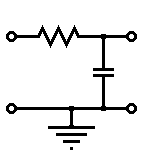
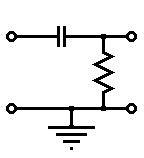
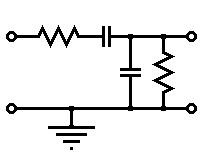
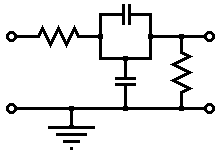
Schematic representations of the passive filter types
| Pin # | 1394a, 4-pin | 1394a, 6-pin | 1394b |
| 1 | TPB- | PWR (8-30VDC) | TPB- |
| 2 | TPB+ | GND | TPB+ |
| 3 | TPA- | TPB- | TPA- |
| 4 | TPA+ | TPB+ | TPA+ |
| 5 | - | TPA- | TPA ref. ground |
| 6 | - | TPA+ | GND |
| 7 | - | - | SC |
| 8 | - | - | PWR (18-25VDC) |
| 9 | - | - | TPB ref. ground |
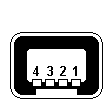
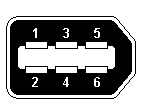
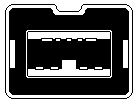
FireWire ports

